
Jennifer Boccia ’20 during her family medicine clerkship at Mad River Medical Center in Waitsfield, Vt.
When Harshal Athalye ’20 began a pediatrics rotation at North Country Hospital in Newport, Vt., in the upper reaches of Vermont’s Northeast Kingdom, he was worried the rural location would make him feel isolated, or that he wouldn’t see the diversity of patients he might in a more urban setting.
The two weeks he spent in Newport during his third-year pediatrics clerkship changed his mind. Working alongside Alexandra Bannach, M.D., a clinical assistant professor of pediatrics, he found a complex caseload that required not only clinical skill, but an ability to build relationships with families over time.
“It was an amazing experience to see her work,” says Athalye. “She has such a calm, optimistic, healing personality. Many of the patients we saw had a troubled history, and Dr. Bannach knew the idiosyncrasies of each patient.”
Athalye is not alone: William Raszka, M.D., professor of pediatrics and director of the pediatrics clerkship, says students who spend time in a rural location often walk away with a newfound appreciation for the complexities and rewards of rural practice. During the seven-week pediatrics clerkship, most students have the opportunity to practice in rural settings across Vermont, as well as in northern New York and Connecticut.
“Physicians in rural environments provide home visits; they staff high school football games and school clinics; sometimes they go to hospitals for deliveries as there may not be a hospitalist service,” he says. “They learn how a physician is incorporated into the community.”
Primary care physicians equipped to practice in rural locations are in dire need across the country. According to the Centers for Disease Control, there’s a “striking gap” in health between rural and urban Americans. The causes are complex, but socioeconomic conditions and access to healthcare play a role. Rural Americans have higher rates of cigarette smoking, high blood pressure, and obesity, according to the CDC. They also have higher rates of poverty, and are less likely to have health insurance. All of this translates into patients who are more at risk for death from preventable causes as compared to their urban counterparts.
The family medicine clerkship at the Larner College of Medicine is designed to introduce students to these health disparities and prepare them to address unmet needs, says Candace Fraser, M.D., associate professor of family medicine and family medicine clerkship director. More than 50 preceptors across Vermont, northern New York, Connecticut, New Hampshire, Massachusetts, and Maine ensure students experience what it’s like to practice at a rural site without quick access to a tertiary care setting. No matter what specialty a student chooses, they benefit from this experience. But for some, it’s the beginning of a career they previously hadn’t considered.
“We have students say ‘I had no idea how important the family doctors are to the community and the extent of the care they provide,’” says Martha Seagrave, PA-C, associate professor of family medicine and director of medical student education programs. “If you don’t experience rural medicine, you wouldn’t necessarily seek it out.”
During the six-week family medicine clerkship, along with caring for all age groups and diverse medical conditions, students complete a community health project focused on a range of topics that address a community need. Past topics have included access to dental care, transportation issues, food insecurity, and drug addiction. This work gets them thinking about how they can have an impact if they choose rural primary care.
“If we’re going to influence population health, we need to have physicians in these locations,” says John King, M.D., professor and vice chair of family medicine.
For Jennifer Boccia ’20, the call of rural medicine is strong. After completing her family medicine clerkship at Mad River Medical Center in Waitsfield, Vt., just down the road from where she lives in Moretown, she’s confident that practice in a rural community is right for her.
“The people I see in the office are neighbors, they work in or own the local businesses that I frequent, they are the relatives of people I know well,” she says. “It’s a very profound feeling to be trusted with the health and well-being of so many people in such a tight-knit community.”